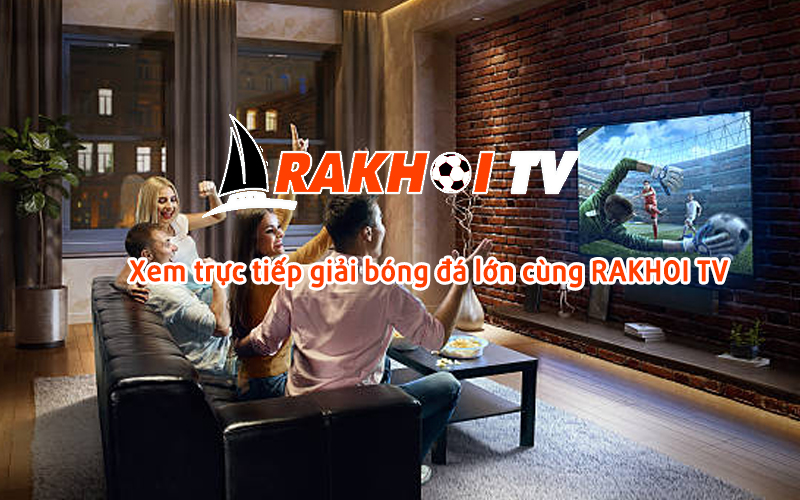Ra Khơi TV hiện tại đang phát sóng truc tiep bong da miễn phí hàng đầu Việt Nam. Khi chúng tôi cập nhật link xem tructiepbongda toàn bộ những giải đấu hàng đầu trong nước và thế giới. Thêm vào đó còn sử dụng công nghệ phát sóng hiện đại. Để mọi người xem bong da truc tiep với chất lượng cao và trải nghiệm tuyệt vời.
- Giới thiệu về trang web trực tiếp bóng đá RaKhơi TV
- Mục tiêu phát triển của trang web trực tiếp bóng đá Rakhoi TV
- Trang web Ra Khơi TV có những điểm nổi bậc nào?
- Giao diện website được thiết kế khoa học và đẹp mắt
- Phát sóng trực tiếp tất cả những giải bóng đá hàng đầu
- Phát sóng tất cả những trận đấu hot, hấp dẫn diễn ra hàng ngày
- Xây dựng hệ thống link xem bong da truc tiep hiện đại
- Phát sóng trực tiếp bóng đá với chất lượng cao
- Phát sóng tructiepbongda với tốc độ cao
- Phát sóng trực tiếp bóng đá với bình luận cuốn hút
- Phát sóng trực tiếp bóng đá không có quảng cáo
- Hướng dẫn cách xem tructiepbongda tại Rakhoi TV
- Những lý do nên xem trực tiếp bóng đá tại Ra Khơi TV
- Những lưu ý khi xem trực tiếp bóng đá tại trang web Ra Khơi TV
- Rakhoi TV – Trang web phát sóng tructiepbongda được yêu thích nhất hiện nay
- Kết luận
- Thông Tin Liên Hệ
Giới thiệu về trang web trực tiếp bóng đá RaKhơi TV

Khi mà công nghệ phát triển, đa số mọi người chuyển từ xem bóng đá trên TV sang xem trực tiếp bóng đá trên mạng. Bởi cách này vừa đơn giản, không tốn phí lại có thể xem trận đấu mình muốn dễ dàng. Biết được điều này, ngay lập tức những chuyên gia bóng đá, biên tập viên và kỹ thuật viên IT chuyên nghiệp đã bắt tay nhau xây dựng lên Rakhoi TV.
Ngay từ khi ra mắt, chúng tôi đã thu hút một số lượng người xem bóng đá trực tiếp cực kỳ đông đảo. Bởi chỉ cần vào đây, mọi người dễ dàng xem các giải bóng đá hàng đầu trong nước và thế giới hiện nay. Chất lượng của các trận đấu mà Ra Khoi TV mang đến cũng không thể chê vào đâu được, từ hình ảnh, âm thanh cho đến tốc độ.
Ra Khơi TV còn có rất nhiều điều đặc biệt khác giúp trải nghiệm xem tructiepbongda của mọi người luôn luôn tuyệt vời. Ngoài ra, chúng tôi cũng có những tính năng đặc biệt khác. Mà khi sử dụng, mọi người dễ dàng tìm được những thông tin về bóng đá mình cần nhanh chóng hơn.
Mục tiêu phát triển của trang web trực tiếp bóng đá Rakhoi TV
Ra Khơi TV được đầu từ một cách chỉnh chu và bài bản ngay từ đầu. Khi bỏ tiền ra thiết kế một website phát sóng bóng đá trực tiếp cho mọi người sử dụng miễn phí. Thêm vào đó còn mua bản quyền của tất cả những giải bóng đá hàng đầu thế giới hiện nay. Cho nên mục tiêu phát triển của chúng tôi là trở thành địa chỉ xem bóng đá miễn phí số 1 Việt Nam.
Sau nhiều năm phát triển, Ra Khoi TV đã hoàn thành được một phần mục tiêu của mình. Khi chúng tôi đã khẳng định được thương hiệu của mình với rất nhiều những anh em yêu bóng đá. Bằng chứng là số lượng người truy cập vào website Rakhoi TV để xem bóng đá mỗi ngày khá đông đảo.
Trang web Ra Khơi TV cũng luôn có phương châm hoạt động là “đặt trải nghiệm của người xem lên hàng đầu”. Cho nên chúng tôi luôn cố nắng phát triển, nâng cấp mình hơn mỗi ngày. Để chỉ cần vào đây là mọi người sẽ có được những giây phút xem bong da truc tiep tuyệt vời nhất.
Chính vì thế, nếu anh em đang muốn xem trực tiếp những trận đấu bóng đá hấp dẫn diễn ra hàng ngay thì hãy chọn RakhoiTV ngay. Chắc chắn rằng những gì mà chúng tôi mang lại sẽ không bao giờ làm anh em thất vọng.
Trang web Ra Khơi TV có những điểm nổi bậc nào?
Hiện tại Ra Khoi TV đang được người xem đánh giá là một trong những website tructiepbongda hàng đầu Việt Nam. Bởi chúng tôi có những ưu điểm nổi bậc so với các trang web khác như:
Giao diện website được thiết kế khoa học và đẹp mắt
Khi vào trang web Ra Khoi Live, điều đầu tiên mà anh em nhìn thấy chính là giao diện được thiết kế cực kỳ thông minh. Bởi chúng tôi đã chia ra từng mục khác nhau. Trong đó mỗi mục sẽ là một chức năng mà chúng tôi cung cấp. Điều này giúp anh em có thể sử dụng một cách dễ dàng.
Màu sắc được chúng tôi lựa chọn cho trang web cũng khá hài hoà và đẹp mắt. Khi sẽ màu nổi bậc những chức năng quan trọng, giúp anh em tìm nhanh hơn. Thêm vào đó khi sử dụng lâu thì anh em cũng không có hiện tượng đau hay mỏi mắt.
Phát sóng trực tiếp tất cả những giải bóng đá hàng đầu
Không phải quá tự tin nhưng có thể nói rằng Rakhoi Live là một trong những website xem bong da truc tiep tại Việt Nam có đầy đủ bản quyền phát sóng của các giải đấu lớn. Khi chúng tôi đã bỏ ra một số tiền khá lớn để mua thành công bản quyền của các giải đấu hấp dẫn nhất thế giới và trong nước hiện nay như:
- Cúp C1 – UEFA Champions League
- Giải vô địch Ngoại hạng Anh – Premier League
- Cúp C2 – Europa League
- Giải vô địch bóng đá Ý – Serie A
- Giải vô địch bóng đá Tây Ban Nha – La Liga
- Giải vô địch bóng đá Đức – Bundesliga
- Giải vô địch bóng đá Pháp – Ligue 1
- Giải vô địch bóng đá Việt Nam – Vleague
- Các giải đấu nhiều năm tổ chức 1 lần như World Cup, Euro, Copa America,…
- Các giải đấu mà đội tuyển Việt Nam tham gia như AFF Cup, U23 Châu Á, vòng loại World Cup, Sea Games,…
Để anh em biết được hôm nay Ra Khơi phát sóng những trận đấu bóng đá nào. Chúng tôi cũng cập nhật lich truc tiep bong da khá sớm với đầy đủ thông tin cho anh em tham khảo. Qua đó dễ dàng biết thời gian diễn ra trận đấu mà mình muốn xem.
Phát sóng tất cả những trận đấu hot, hấp dẫn diễn ra hàng ngày
Trang web Rakhoi TV biết được rằng đa số mọi người đều muốn xem các trận đấu lớn, hấp dẫn nhất diễn ra mỗi ngày. Cho nên chúng tôi cũng luôn luôn ưu tiên việc trực tiếp các trận đấu của những CLB hàng đầu thế giới như Man City, Real Madrid, Man United, Barcelona, AC Milan, PSG, Bayern Munich,…
Chính vì thế chỉ cần truy cập vào đây, anh em dễ dàng tìm và xem được những trận đấu bóng đá hot, hấp dẫn diễn ra hàng ngày.
Xây dựng hệ thống link xem bong da truc tiep hiện đại
Để cung cấp cho người xem được những đường link xem tructiepbongda chất lượng cao. Chúng tôi đã ứng dụng nhiều công nghệ hiện đại và sử dụng server tốt nhất hiện nay. Để xây dựng một hệ thống link uy tín như sau:
- Những trận đấu bóng đá mà chúng tôi phát sóng luôn được cập nhật link xem trực tiếp từ khá sớm cho anh em truy cập
- Mỗi trận đấu sẽ được chúng tôi cung cấp trên 3 đường link với nhiều chất lượng hình ảnh khác nhau. Để anh em chọn được đường link phù hợp với mình
- Anh em cũng hoàn toàn yên tâm rằng đường link mà chúng tôi cung cấp sẽ không bao giờ chứa mã độc hay bị lỗi. Cho nên sẽ không ảnh hưởng đến thiết bị xem của anh em.
Phát sóng trực tiếp bóng đá với chất lượng cao

Hiện tại chúng tôi cũng là một trong những trang web tructiepbongda đầu tiên tại Việt Nam ứng dụng công nghệ phát sóng 4.0. Để mang đến cho người xem những trận đấu bóng đá với chất lượng hình ảnh và âm thanh khá cao như sau:
- Hình ảnh mà anh em nhìn thấy trong trận đấu cực kỳ sắc nét, bởi độ phân giải sẽ từ SD đến Full HD
- Âm thanh mà anh em nghe được thì lúc nào cũng chân thực với âm lượng lớn
- Anh em còn được xem trận đấu trên một màn hình với kích thước đúng chuẩn và tương thích với tất cả các thiết bị xem.
Trong quá trình xem trận đấu mình thích tại đây, anh em cũng có thể thay đổi độ phân giải của hình ảnh hay tăng giảm âm lượng, kích thước màn hình. Sao cho anh em cảm thấy phù hợp nhất với mình là được.
Phát sóng tructiepbongda với tốc độ cao
Không chỉ ứng dụng công nghệ phát sóng 4.0. Trang web Ra Khơi TV còn sử dụng đường truyền với tốc độ cao nhất hiện nay là P2P. Chính vì thế tất cả những trận đấu mà chúng tôi trực tiếp có tốc độ cực kỳ mượt mà, ổn định không khác gì xem trên TV.
Thêm vào đó, anh em còn không bao giờ gặp những hiện tượng như giật, đứng hình hay bị diss ra trong quá trình mà trận đấu diễn ra. Thay vào đó, trận đấu sẽ diễn ra từ đầu cho đến cuối mà không bị delay giây phút nào.
Phát sóng trực tiếp bóng đá với bình luận cuốn hút
Một trong những điểm nổi bậc nữa của Rakhoi TV với các trang web xem bong da truc tiep khác. Đó là chúng tôi đang có đội ngũ bình luận viên bóng đá đông đảo và chuyên nghiệp nhất Việt Nam. Bởi chúng tôi biết rằng tất cả mọi người khi xem tructiepbongda đều muốn nghe bình luận bằng tiếng Việt. Cho nên Ra Khoi TV đã chi một số tiền khá lớn để chiêu mộ rất nhiều BLV tên tuổi, được yêu thích ở Việt Nam hiện tại.
Chính vì thế khi xem bất kỳ trận đấu nào mà chúng tôi phát sóng. Anh em luôn nghe được bình luận bằng tiếng Việt dễ dàng. Với việc được bình luận từ các BLV của chúng tôi thì không khí của trận đấu sẽ trở nên sinh động, cuốn hút và vui vẻ hơn rất nhiều.
Đặc biệt, các bình luận viên của Rakhoi TV còn cực kỳ thân thiện. Khi thường xuyên tương tác, giao lưu với người xem trong trận đấu. Đương nhiên anh em cũng có thể trò chuyện lại bằng cách đặt những câu hỏi mà mình muốn tại khung chat. Đây là một trải nghiệm xem trực tiếp bóng đá cực kỳ thú vị mà khi xem trên TV không bao giờ có được.
Phát sóng trực tiếp bóng đá không có quảng cáo
Trang web Ra Khơi TV hiện tại không thu phí người xem dưới bất kỳ hình thức nào. Nhưng cũng cam kết với người xem rằng không bao giờ chèn quảng cáo khi trận đấu đã chính thức diễn ra. Cho nên trong quá trình xem bong da truc tiep tại đây. Anh em sẽ không bị quảng cáo làm phiền bất kỳ giây phút nào.
Hướng dẫn cách xem tructiepbongda tại Rakhoi TV
Như chúng tôi đã chia sẻ ở trên thì giao diện của trang web Ra Khơi TV rất dễ sử dụng cho tất cả mọi người. Chính vì thế để tìm và xem bất kỳ trận đấu bóng đá nào tại đây, anh em chỉ cần thực hiện theo các bước sau:
- Bước 1: Đầu tiên anh em sẽ chuẩn bị máy tính, điện thoại thông minh hoặc laptop được kết nối mạng rồi truy cập vào các trình duyệt như Google, Cốc Cốc, Firefox,…
- Bước 2: Tiếp theo anh em sẽ nhập các từ khoá sau vào ô tìm kiếm “xem trực tiếp bóng đá Rakhoi TV”, “xem bong da truc tiep ra Khơi TV”, “xem tructiepbongda Ra Khoi Live”,…
- Bước 3: Khi website xuất hiện trên thì anh em sẽ truy cập vào. Sau đó nhấn vào mục Trang Chủ trên thanh Công Cụ rồi dựa vào giải đấu hoặc thời gian thi đấu để tìm trận đấu mình muốn xem
- Bước 4: Cuối cùng khi tìm được trận đấu thì anh em chỉ cần nhấn Xem Ngay và chọn đường link phù hợp với mình là xong.
Trang web của chúng tôi tương thích với tất cả những hệ điều hành hiện nay. Cho nên anh em có thể truy cập vào đây bằng bất kỳ thiết bị nào để xem bóng đá trực tiếp.
Những lý do nên xem trực tiếp bóng đá tại Ra Khơi TV
Ra Khoi TV chính là website mà anh em nên truy cập vào ngay lập tức. Khi muốn xem trực tiếp bất kỳ trận đấu bóng đá nào diễn ra hàng ngày. Bởi những lý do chính sau đây:
- Rakhoi TV hoạt động dưới hình thức phi lợi nhuận. Có nghĩa là không thu phí người xem của mình dưới bất kỳ hình thức nào. Cho nên anh em có thể truy cập vào đây để xem bóng đá mà không mất phí
- Giao diện của chúng tôi cũng được thiết kế khoa học và đẹp mắt. Để anh em sử dụng một cách dễ dàng để tìm thông tin mình cần nhanh chóng hơn
- Chúng tôi đang nắm trong tay bản quyền của tất cả những giải bóng đá lớn ở trong nước, khu vực và cả thế giới. Cho nên chỉ cần vào đây, anh em có thể xem những trận đấu hấp dẫn diễn ra mỗi ngày dễ dàng
- Đường link xem tructiepbongda cũng luôn được Ra Khoi Live cập nhật khá sớm và đa dạng cho anh em lựa chọn. Đương nhiên link cũng không chứa mã độc hay virus, nên anh em hoàn toàn có thể yên tâm
- Ra Khoi TV cũng mang đến cho anh em những trận đấu bóng đá với chất lượng hình ảnh lên đến Full HD sắc nét và âm thanh cực kỳ sống động. Đi kèm với đó, anh em còn được xem trên một màn hình với kích thước đúng chuẩn
- Trong quá trình xem bong da truc tiep tại đây, anh em cũng dễ dàng tùy chỉnh lại âm lượng, kích thước màn hình hay độ phân giải bất kỳ lúc nào. Miễn sao anh em cảm thấy phù hợp với mình nhất
- Chúng tôi còn sử dụng đường truyền hiện đại. Cho nên tất cả các trận đấu mà Ra Khơi TV phát sóng cũng có tốc độ cực kỳ mượt mà, ổn định. Qua đó anh em không còn phải gặp những tình trạng như giật, lag hay đứng hình
- Trang web Rakhoi Live còn đang có đội ngũ bình luận viên bóng đá hàng đầu Việt Nam. Để tham gia bình luận cho những trận đấu hấp dẫn diễn ra hàng ngày. Điều này giúp không khí mà anh em cảm nhận trong trận đấu trở nên sinh động và cuốn hút hơn rất nhiều
- Trong quá trình xem trận đấu, anh em cũng được tương tác, giao lưu với các người xem khác hay bình luận viên dễ dàng
- Đặc biệt, chúng tôi luôn đặt trải nghiệm của người xem lên hàng đầu. Cho nên cam kết không bao giờ chèn quảng cáo khi trận đấu đã chính thức diễn ra. Để khi xem bất kỳ trận đấu nào tại đây, anh em sẽ không bị làm phiền giây phút nào.
Những lưu ý khi xem trực tiếp bóng đá tại trang web Ra Khơi TV
Để xem tructiepbongda tại Rakhoi TV một cách tốt nhất. Anh em nên lưu ý những điều sau:
- Anh em nên có kết nối đường truyền internet tốc độ cao. Bởi dù chúng tôi đang sử dụng đường truyền hiện đại nhất hiện nay. Nhưng nếu kết nối internet của anh em có vấn đề thì trận đấu vẫn có thể xuất hiện các tình trạng gây ức chế như đứng hình, lag hay bị diss ra khi đang xem
- Nếu như kết nối internet của anh em tốt. Nhưng trong quá trình xem trận đấu vẫn xuất hiện giật hay lag thì anh em hãy cho dừng trận đấu lại khoảng 10s. Sau đó tiếp tục xem thì tình trạng này sẽ được khắc phục ngay lập tức
- Đối với những trận đấu bóng đá hấp dẫn, được nhiều người xem. Anh em hãy truy cập và lấy đường link càng sớm càng tốt. Bởi càng về sau thì số lượng người truy cập càng nhiều. Như vậy rất dễ dẫn đến tình trạng link quá tải và anh em không thể vào được nữa
- Mỗi trận đấu sẽ được chúng tôi cung cấp nhiều đường link xem bong da truc tiep khác nhau. Trong đó cách đường link sẽ có chất lượng hình ảnh khác nhau. Để xem trận đấu một cách tốt nhất, anh em hãy chọn đường link phù hợp với mình. Ví dụ như thiết bị xem của anh em không hiện đại thì chọn link có độ phân giải hình ảnh thấp và ngược lại
- Trong quá trình xem trận đấu mà đường link của anh em gặp bất kỳ sự cố gì. Anh em chỉ cần đổi sang link khác là có thể tiếp tục xem trận đấu.
Rakhoi TV – Trang web phát sóng tructiepbongda được yêu thích nhất hiện nay
Rất nhiều anh em yêu bóng đá truy cập vào website Ra Khoi TV mỗi ngày. Không chỉ bởi chúng tôi phát sóng tructiepbongda miễn phí với chất lượng cao cho anh em thưởng thức. Mà còn bởi chúng tôi có rất nhiều chức năng hữu ích cho mọi người sử dụng. Để mọi người tìm tìm các thông tin bóng đá mình cần nhanh và chính xác hơn như:
Xem tin tức bóng đá mới nhất
Ra Khoi Live đang có rất nhiều các biên tập viên bóng đá làm việc 24/24. Để tìm kiếm và cập nhật những tin tức, sự kiện về bóng đá mới nhất cho anh em tham khảo. Để anh em biết được trong vòng 24 giờ qua, tình hình bóng đá trong nước và thế giới như thế nào.
Tin tức mà chúng tôi cập nhật cũng đa dạng, từ tin chuyển nhượng, trước trận đấu, bên lề sân cỏ, cầu thủ, huấn luyện viên,… Chúng tôi cũng cam kết các tin tức mà mình cung cấp chính xác tuyệt đối. Cho nên anh em hoàn toàn có thể yên tâm khi tham khảo hay sử dụng.
Xem bảng xếp hạng bóng đá

Chúng tôi hiện tại cũng đang cập nhật BXH cho tất cả những giải bóng đá trên toàn thế giới. Cho nên khi vào đây, anh em dễ dàng xem được bảng xếp hạng của giải đấu mình muốn. Trong BXH cũng có đầy đủ những thông tin quan trọng như:
- Vị trí trên bảng xếp hạng
- Điểm số của mỗi đội
- Số vòng thi đấu
- Hiệu số thắng/ thua
- Thành tích trong 5 trận đấu gần nhất.
Tất cả những thông tin trong BXH cũng được chúng tôi cập nhật dựa vào kết quả trận đấu gần nhất, nên cực kỳ chính xác. Qua đó anh em dễ dàng biết thành tích của các CLB tham gia giải đấu chuẩn nhất.
Xem lịch thi đấu bóng đá
Để biết lịch thi đấu của các trận đấu hấp dẫn hay đội bóng mình yêu thích thì anh em cũng nên truy cập vào Ra Khơi TV. Bởi chúng tôi đang cập nhật lịch cho tất cả những giải đấu. Chính vì thế toàn bộ những trận đấu diễn ra hôm nay và ngày mai đều được Rakhoi TV cập nhật lịch đầy đủ.
Khi xem lịch bóng đá trực tuyến tại đây, anh em cũng nắm được đầy đủ thông tin như thời gian mà trận đấu chính thức diễn ra, đội hình dự kiến ra sân, địa điểm tổ chức trận đấu, trọng tài bắt chính,… Giúp anh em thu xếp thời gian xem trận đấu mình muốn hợp lý.
Xem kết quả bóng đá
Tại RakhoiTV, anh em không chỉ được xem truc tiep bong da với chất lượng cao. Mà khi trận đấu kết thúc, anh em sẽ biết được kết quả ngay lập tức. Bởi chúng tôi đang cập nhật kết quả cho tất cả những trận đấu khi vừa kết thúc, dù ở giải đấu nào.
Khi xem kết quả của bất kỳ trận đấu nào tại đây, anh em sẽ biết tỷ số cuối cùng của trận đấu, cầu thủ ghi bàn, kiến tạo, số lần ném biên, phạt góc, thời gian kiểm soát bóng của hai đội,… khá chi tiết và chuẩn xác.
Xem video highlight

Chúng tôi biết được rằng mọi người thường xem lại highlight khi không thể xem trực tiếp trận đấu mình muốn. Cho nên đã xây dựng chuyên mục Highlight cực kỳ hữu ích. Bởi tại đây Rakhoi Live sẽ tổng hợp highlight cho toàn bộ những trận đấu bóng đá lớn khi kết thúc.
Chính vì thể chỉ cần vào đây là anh em có thể xem lại highlight của trận đấu mà mình đã bỏ lỡ ngay. Trong video thì sẽ bao gồm toàn bộ những diễn biến chính của trận đấu, các tình huống dẫn đến bàn thắng, các pha bóng nguy hiểm,… Mà khi xem anh em sẽ biết hai đội thi đấu như thế nào khá chi tiết.
Chất lượng trong video highlight mà chúng tôi cung cấp cũng khá cao. Khi trong video, anh em sẽ nhìn thấy độ phân giải hình ảnh cao, âm thanh thì chân thực và tốc độ load mượt mà.
Xem tỷ lệ kèo nhà cái
Ra Khơi Live cũng là website mà anh em nên truy cập vào ngay. Khi muốn xem kèo nhà cái trực tuyến của bất kỳ trận đấu nào. Bởi chúng tôi đang cập nhật kèo cho toàn bộ các giải bóng đá. Chính vì thế tất cả những trận đấu diễn ra hàng ngày đều được cung cấp bảng kèo đầy đủ.
Khi xem bảng kèo bóng đá tại đây, anh em cũng nắm được đầy đủ các thể loại kèo khác nhau. Thêm vào đó, thông tin trong bảng kèo chính xác tuyệt đối. Để anh em có thể soi kèo trận đấu mình muốn tốt hơn khá nhiều
Xem nhận định trước trận đấu
Chúng tôi hiện tại cũng đang có đội ngũ chuyên gia cá cược bóng đá hàng đầu. Với nhiệm vụ nghiên cứu, phân tích những trận đấu bóng đá lớn diễn ra hàng ngày. Sau đó đưa ra nhận định, dự đoán về trận đấu cho anh em tham khảo hoàn toàn miễn phí.
Khi xem nhận định trước trận đấu tại Ra Khoi TV, anh em sẽ biết chuyên gia dự đoán tất cả các thể loại kèo như thế nào khá chuẩn. Mà dựa vào đó, anh em sẽ đưa ra quyết định cá cược với tỷ lệ chiến thắng khá cao.
Ứng dụng Livescore
Trang web Rakhoi Live còn cung cấp cả ứng dụng Livescore cho anh em sử dụng miễn phí. Đây là một ứng dụng cực kỳ hữu ích cho anh em yêu bóng đá. Bởi có nhiều tính năng hữu ích như:
- Anh em có thể xem thông tin về bóng đá cực kỳ nhanh chóng và chuẩn xác
- Xem thể thao trực tiếp với nhiều môn như bóng chuyền, bóng rổ, quyền anh, đua xe,… với chất lượng khá cao
- Xem tỷ số bóng đá trực tuyến những trận đấu đang diễn ra nhanh và chuẩn xác. Qua đó không cần phải theo dõi trực tiếp trận đấu nhưng vẫn biết kết quả như thế nào dễ dàng.
Kết luận
Hiện tại, Rakhoi TV vẫn đang không ngừng nâng cấp và phát triển. Để thành một địa chỉ xem truc tiep bong da hàng đầu Việt Nam. Giúp mọi người dễ dàng xem những trận đấu bóng đá hấp dẫn diễn ra hàng ngày với chất lượng và trải nghiệm tuyệt vời nhất. Chính vì thế nếu anh em đang muốn xem tructiepbongda thì hãy đồng hành cùng với chúng tôi. Đảm bảo rằng anh em sẽ không bao giờ thất vọng.
Thông Tin Liên Hệ
Mọi ý kiến đóng góp cho sự phát triển chung của chúng tôi vui lòng liên hệ qua thông tin sau:
Website: https://rakhoiz.com/
Email: [email protected]
Đia chỉ: 36 Võ Văn Tần, Phuờng 2, Quận 3, Hồ Chí Minh.
Phone: 0354876689
- Twitter: https://twitter.com/rakhoitv365/
- Fanpage: https://www.facebook.com/rakhoitv365/
- About: https://about.me/rakhoitv365/
- Telegram: https://t.me/s/rakhoitv365/






















































